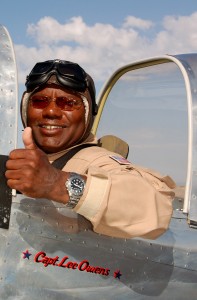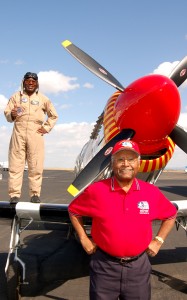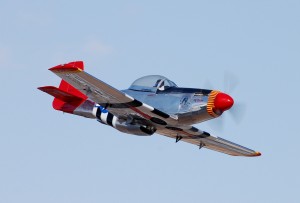
Pilot Lee Owens wants to fly around the world as a tribute to the Tuskegee Airmen in his replica P-51, based at Glendale Airport. The aircraft is painted in the authentic markings of the Tuskegee Airmen, which includes the unique red tail.
By Bob Shane
When not performing his duties as chief pilot for Glendale Aviation in Glendale, Ariz., Lee Owens is busy making preparations for the flight of a lifetime. His dream is to make history by becoming the first African-American pilot to fly solo around the world in a single-engine aircraft.
The current flight plan has Owens traveling a distance in excess of 19,000 miles. A strict circumnavigation of the earth requires a minimum distance of 24,859.75 miles. Wiley Post made the earliest solo around the world flight in 1933. Post took off from New York’s Floyd Bennett Field on July 15, 1933, flying Winnie Mae, a Lockheed Vega. When he landed back at Floyd Bennett Field on July 22, he had traveled only 15,596 miles. The flight was made at too high a latitude to qualify as a complete circumnavigation.
Owens conceived the idea for the global flight back in 2001.
“I wanted to do something for the anniversary of 100 years of flight, as well as perpetuate the story of the achievements of the famed Tuskegee Airmen,” he said.
The Tuskegee Airmen were a group of World War II black aviators whose heroic exploits in aerial combat made them legendary. During the war, 994 pilots successfully completed the Tuskegee Program. The first class of black military airmen graduated on March 6, 1942, and included Capt. Benjamin O. Davis Jr., who later became the Tuskegee Airmen commanding officer. Their story tells of triumph over adversity and discrimination. The group had the unparalleled distinction of never losing a bomber they were escorting to enemy fire.
In May 2001, Owens called Tuskegee Airmen Inc., and told them what he wanted to do. In August 2002, he went to the Tuskegee Airmen’s convention in Atlanta, where he was given five minutes to sell his grandiose plan. After receiving the group’s endorsement, he began the process of trying to raise the financing needed to make his flight a reality.
His initial target was to fly in 2003. Now, he’s shooting for sometime between June 1 and July 15, 2007. Funding has been his biggest hurdle.

Lee Owens named his airplane By Desire, representing his desire to fly it around the world to commemorate the accomplishments of the Tuskegee Airmen. The 3/4 scale P-51 displays a picture of Cdr. Benjamin O. Davis Jr., the Tuskegee Airmen’s first CO.
“We could go tomorrow if we had the money,” he said.
An estimated $250,000 is still needed if the flight is to be made this year.
The P-51D was one of the aircraft used by the Tuskegee Airmen. Six months ago, Owens took delivery of a 3/4 scale replica P-51 Mustang, designed by Titan Aircraft in Austinburg, Ohio. Lt. Col. Emrett W. Groomes donated the $160,000 for the aircraft.
“I believe in the mission,” Groomes said.
The replica is powered by a Rotax 912S four-cylinder engine, has a cruise speed of 150 mph and a ceiling of 16,000 feet. The basic fuel system will have to be modified to increase the aircraft’s range.
Painted in the authentic markings of the Tuskegee Airmen, the “Red Tail” replica fighter also displays a picture of Cdr. Benjamin O. Davis Jr. By Request is the name Davis gave his P-51 when bomber groups began to specifically request the red-tailed fighters for their escorts. Owens has named his aircraft By Desire, illustrating the personal motivation and commitment he has for his proposed flight around the world.
At age 57, Owens has had a varied and full aviation career. He grew up in the Mississippi cotton fields as the son of a laborer. One of his responsibilities was loading crop-dusting aircraft. It was then that he realized he wanted to fly. Owens has a degree from Southern Illinois University in aviation management. He’s been a charter pilot, flight instructor and director of flight operations. He has an ATP rating and flew freight at night for an operator contracted to Federal Express.
The Tuskegee Airmen bond
Through his goal, Owens has forged a strong bond with the Tuskegee Airmen. This is particularly true of the association he has with members of the Archer-Ragsdale Arizona Chapter in Phoenix. Asa Herring, Tuskegee Airmen, often joins Owens at various functions and events promoting the flight.
Herring, a true gentleman, is typical of his peers. He began his active duty status on Dec. 27, 1944. As an aviation cadet, he flew the Stearman PT-17 and the AT-6 and later flew the P-51. When it was apparent that WWII was in its final stages and Germany had surrendered, the “Tuskegee Experiment” was one of numerous flight schools destined to be eliminated. With flying being drastically curtailed, volunteers were given the option to take an honorable discharge, which Herring took.
He continued his education at several technical schools, but was unable to secure employment with an airline or fixed base operator. By that time the Air Force had become an autonomous branch of the military and military segregation had been banned pursuant to an executive order signed by President Harry S. Truman. Herring volunteered to go back on active duty in June 1949.
Herring retired in June 1970 at the rank of lieutenant colonel. During the Vietnam War, he flew 350 combat missions and was the first black squadron commander at Luke Air Force Base. He trained foreign pilots in the F-104G Advanced Jet Fighter Gunnery Program and was made an honorary command pilot in the German Luftwaffe.
The flight
Owens will start his historic flight from the Lincoln J. Ragsdale Terminal at Phoenix Sky Harbor International Airport. The terminal was named after a member of the Tuskegee Airmen who was also a civil rights crusader with a passion for aviation. In the 1970s, he served on the Phoenix Aviation Advisory Board.
The current flight plan for the journey around the world includes stops in St. Louis, Tuskegee, Ala., and Republic Field in Farmingdale, N.Y., close to where Charles Lindbergh made his historic flight to Paris. Owens plans to cross the Atlantic via Newfoundland, Greenland and Iceland. The European routing includes Paris, Sigonella in Sicily and Anzio Beach, the site of the first air-to-air combat involving the Tuskegee Airmen. The Berlin to Moscow leg will be reminiscent of the Wiley Post flight.
Owens will continue across Russia to Nome and Anchorage, Alaska; Seattle; Reno, Nev.; Long Beach, Calif.; and finally Phoenix Sky Harbor International Airport.
“The Tuskegee Airmen laid the groundwork for me to fly,” Owens said.
However, his historic flight will be more than a tribute to the famed black aviators. Owens sees it as an opportunity to give pride to younger people of color and inspire them to doing things they never considered before. Owens counsels and encourages young people.
“You have to have the right role models to succeed,” he tells them. “With values like the Tuskegee Airmen have, how can you not want to emulate them and pass their values on to future generations?”
Owens also encourages young people to learn to fly.
“If you want instant gratification, learn how to fly an airplane,” he says. “An airplane has no preconceptions or prejudices; it recognizes only the input provided by the pilot.”
Owens himself has contributed thousands of dollars to the dream.
“I believe in the mission so strongly that I’m willing to put my life on the line to get it accomplished,” he said. “This is not about black and white. I have an American flag on my flight suit. I’m proud to be an American and thankful for the opportunities I have as an American.”
For more information concerning this historical event or how to become a sponsor, contact Lee Owens at 623-206-6248 or visit [http://www.leeowensfoundation.org].














